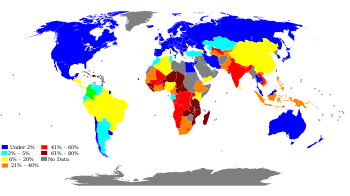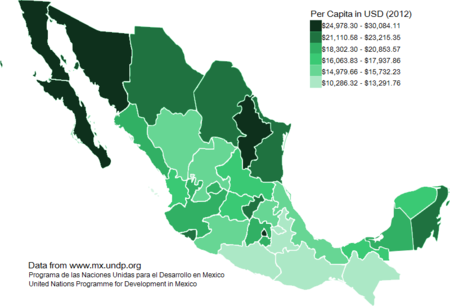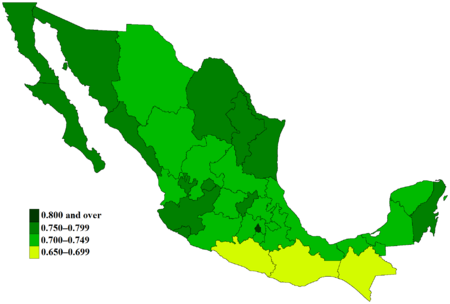اقتصاد المكسيك
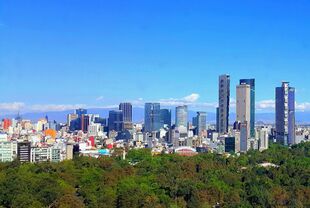 مكسيكو سيتي، المركز المالي للمكسيك. | |
| العملة | الپيسو المكسيكي (MXN, Mex$) |
|---|---|
| calendar year | |
منظمات التجارة | APEC، CPTPP، USMCA، OECD ،WTO |
| احصائيات | |
| السكان | ▲ 128.649.565 (تقديرات 2020)[1] |
| ن.م.إ | |
| ترتيب ن.م.إ | |
نمو ن.م.إ |
|
ن.م.إ للفرد | |
ن.م.إ للفرد | |
| 2.7% (تقديرات 2020)[3] | |
السكان تحت خط الفقر |
|
| ▼ 41.5 متوسط (2020)[7] | |
القوة العاملة | |
القوة العاملة حسب المهنة | |
| البطالة | |
الصناعات الرئيسية | |
| الخارجي | |
| الصادرات | ▲ 491.6 بليون دولار (تقديرات 2019)[1] |
السلع التصديرية | السلع المصنعة، الإلكترونيات، السيارات وقطع الغيار، النفط ومنتجات النفط، الفضة، اللدائن، الفواكه، الخضروات، البن، القطن |
شركاء التصدير الرئيسيين | |
| الواردات | ▲ 467.2 بليون دولار (تقديرات 2019)[1] |
السلعة المستوردة | آلات تشغيل المعادن، منتجات مصانع الصلب، الآلات الزراعية، الأجهزة الكهربائية، قطع خيار السيارات للتجميع والإصلاح، الطائرات، قطع غيار الطائرات، اللدائن، منتجات الغاز الطبيعي والنفط |
شركاء الاستيراد الرئيسيين |
|
رصيد ا.أ.م | |
| ▲ −19.35 بليون دولار (تقديرات 2017)[1] | |
إجمالي الديون الخارجية | ▼ 445.8 بليون دولار (تقديرات 31 ديسمبر 2017)[1] |
| المالية العامة | |
| ▼ 54.3% من ن.م.إ. (تقديرات 2017)[1] | |
| العوائد | 261.4 بليون (تقديرات 2017)[1] |
| النفقات | 273.8 بليون (تقديرات 2017)[1] |
| المعونات الاقتصادية | 189.4 مليون دولار (2008) |
احتياطيات العملات الأجنبية | ▲ 201.287 بليون دولار (نوفمبر 2020)[15] |
The economy of Mexico is the 15th largest in the world in nominal terms and the 11th largest by purchasing power parity, according to the International Monetary Fund.[16] Since the 1994 crisis, administrations have improved the country's macroeconomic fundamentals. Mexico was not significantly influenced by the 2002 South American crisis, and maintained positive, although low, rates of growth after a brief period of stagnation in 2001. However, Mexico was one of the Latin American nations most affected by the 2008 recession with its Gross Domestic Product contracting by more than 6% in that year.
The Mexican economy has had an unprecedented macroeconomic stability, which has reduced inflation and interest rates to record lows and has increased per capita income. In spite of this, enormous gaps remain between the urban and the rural population, the northern and southern states, and the rich and the poor.[17] Some of the unresolved issues include the upgrade of infrastructure, the modernization of the tax system and labor laws, and the reduction of income inequality. Tax revenues, all together 19.6 percent of GDP in 2013, are the lowest among the 34 OECD countries.[18]
The economy contains rapidly developing modern industrial and service sectors, with increasing private ownership. Recent administrations have expanded competition in ports, railroads, telecommunications, electricity generation, natural gas distribution and airports, with the aim of upgrading infrastructure. As an export-oriented economy, more than 90% of Mexican trade is under free trade agreements (FTAs) with more than 40 countries, including the European Union, Japan, Israel, and much of Central and South America. The most influential FTA is the North American Free Trade Agreement (NAFTA), which came into effect in 1994, and was signed in 1992 by the governments of the United States, Canada and Mexico. In 2006, trade with Mexico's two northern partners accounted for almost 90% of its exports and 55% of its imports.[19] Recently, the Congress of the Union approved important tax, pension and judicial reforms, and reform to the oil industry is currently being debated. Mexico had 15 companies in the Forbes Global 2000 list of the world's largest companies in 2016.[20]
Mexico's labor force is 52.8 million as of 2015.[21] The OECD and WTO both rank Mexican workers as the hardest-working in the world in terms of the amount of hours worked yearly, although profitability per man-hour remains low.[22][23][24][25][26]
. . . . . . . . . . . . . . . . . . . . . . . . . . . . . . . . . . . . . . . . . . . . . . . . . . . . . . . . . . . . . . . . . . . . . . . . . . . . . . . . . . . . . . . . . . . . . . . . . . . . . . . . . . . . . . . . . . . . . . . . . . . . . . . . . . . . . . . . . . . . . . . . . . . . . . . . . . . . . . . . . . . . . . . .
History

Mexican president Porfirio Díaz brought unprecedented economic growth during the last quarter of the nineteenth century. This growth was accompanied by foreign investment and European immigration, the development of an efficient railroad network and the exploitation of the country's natural resources. Annual economic growth between 1876 and 1910 averaged 3.3%.[27]
Political repression and fraud, as well as huge income (in)equalities exacerbated by the land distribution system based on latifundios, in which large haciendas were owned by a few but worked by millions of underpaid peasants living in precarious conditions, led to the Mexican Revolution (1910–1920), an armed conflict that drastically transformed Mexico's political, social, cultural, and economical structure during the twentieth century under a premise of social democracy. The war itself left a harsh toll on the economy and population, which decreased over the 11-year period between 1910 and 1921.[بحاجة لمصدر] The reconstruction of the country was to take place in the following decades.
| Average annual GDP growth by period | ||
|---|---|---|
| 1900–1929 | 3.4% | |
| 1929–1945 | 4.2% | |
| 1945–1972 | 6.5% | |
| 1972–1981 | 5.5% | |
| 1981–1995 | 1.5% | |
| 1983 Debt Crisis | -4.2% | |
| 1995 Peso Crisis | -6.2% | |
| 1995–2000 | 5.1% | |
| 2001 US Recession | -0.2% | |
| 2009 Great Recession | -6.5% | |
| Sources:[28][29][30][31] | ||
Macroeconomic, financial and welfare indicators
| GDP per capita PPP | US $16,900 (2012–15) |
|---|---|
| GNI per capita PPP | US $16,500 (2012–15) |
| Inflation (CPI) | 2.21% (November 2015) |
| Gini index | 47.0 (World Bank 2012) |
| Unemployment | 5.5% (April 2010) |
| HDI | ▲ 0.770 (2011) |
| Labor force | 78.4 million (2011) |
| Pop. in poverty | 13.8% |
Main indicators
Poverty
Income inequality
Regional economies
Agriculture
History
| Food and agriculture | ||
|---|---|---|
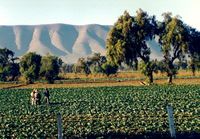
| ||
| Farmers in Puebla | ||
| Product | Quantity (Tm) | World Rank1 |
| Avocados | 1,040,390 | 1 |
| Onions and chayote | 1,130,660 | 1 |
| Limes and lemons | 1,824,890 | 1 |
| Sunflower seed | 212,765 | 1 |
| Dry fruits | 95,150 | 2 |
| Papaya | 955,694 | 2 |
| Chillies and peppers | 1,853,610 | 2 |
| Whole beans | 93 000 | 3 |
| Oranges | 3,969,810 | 3 |
| Anise, badian, fennel | 32 500 | 3 |
| Chicken meat | 2,245,000 | 3 |
| Asparagus | 67,247 | 4 |
| Mangoes | 1.503.010 | 4 |
| Corn | 20,000,000 | 4 |
| 1Source:FAO[32] | ||
Industry
| Industrial production | ||
|---|---|---|
| Main industries | Aircraft, automobile industry, petrochemicals, cement and construction, textiles, food and beverages, mining, consumer durables, tourism | |
| Industrial growth rate | 3.6% (2006) | |
| Labor force | 29% of total labor force | |
| GDP of sector | 25.7% of total GDP | |
OEM and ODM manufacturing

Engineering and Design
[[File:ITESM Ciudad de México Set Dominguez.jpg|thumb|200px|The Monterrey Institute of Technology and Higher Education
. . . . . . . . . . . . . . . . . . . . . . . . . . . . . . . . . . . . . . . . . . . . . . . . . . . . . . . . . . . . . . . . . . . . . . . . . . . . . . . . . . . . . . . . . . . . . . . . . . . . . . . . . . . . . . . . . . . . . . . . . . . . . . . . . . . . . . . . . . . . . . . . . . . . . . . . . . . . . . . . . . . . . . . .
Domestic Industry
[[File:LANIX W10 SLATE.jpg|thumb|Lanix W10 Ilium Tablet PC.]]
Oil
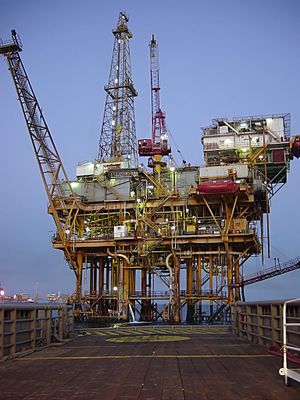
Mineral resources are the "nation's property" (i.e. public property) by constitution. As such, the energy sector is administered by the government with varying degrees of private investment. Mexico is the sixth-largest oil producer in the world, with 3,700,000 barrels per day (590,000 m3/d).[33] Pemex, the public company in charge of administering research, exploration and sales of oil, is the largest company (oil or otherwise) in Mexico, and the second largest in Latin America after Brazil's Petrobras.[34] Pemex is heavily taxed of almost 62 per cent of the company's sales, a significant source of revenue for the government.[29]
Government
Monetary and financial system and regulation
Banco de México
| Financial indicators | ||
|---|---|---|

| ||
| Banco de México headquarters | ||
| Currency exchange rate | 12.74 MXN per US$1 (03/03/2010) | |
| Reserves | US $176.579 billion (2013)[35] | |
| Government budget | US $196.5 billion (revenues) | |
| Public debt | 20.7% of GDP (2006) | |
| External debt | US $178.3 billion (2006) | |
| Bank funding rate | 5.25% (5/15/2009) | |
Banco de México is Mexico's central bank, an internally autonomous public institution whose governor is appointed by the president and approved by the legislature to which it is fully responsible. Banco de México's functions are outlined in the 28th article of the constitution and further expanded in the Monetary Law of the United Mexican States.[36] Banco de México's main objective is to achieve stability in the purchasing power of the national currency. It is also the lender of last resort.
Currency policy
Mexico has a floating exchange rate regime.
Monetary system
Mexico’s monetary policy was revised following the 1994–95 financial crisis, when officials decided that maintaining general price stability was the best way to contribute to the sustained growth of employment and economic activity. As a result, Banco de México has as its primary objective maintaining stability in the purchasing power of the peso. It sets an inflation target, which requires it to establish corresponding quantitative targets for the growth of the monetary base and for the expansion of net domestic credit.
Trade
North American Trade Agreement
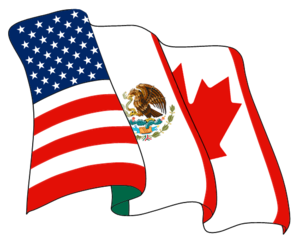
The North American Trade Agreement (NAFTA) is by far the most important Trade Agreement Mexico has signed both in the magnitude of reciprocal trade with its partners as well as in its scope. Unlike the rest of the Free Trade Agreements that Mexico has signed, NAFTA is more comprehensive in its scope and was complemented by the North American Agreement for Environmental Cooperation (NAAEC) and the North American Agreement on Labor Cooperation (NAALC).
See also
- Small and medium enterprises in Mexico
- List of companies of Mexico
- List of hotels in Mexico
- List of Mexican brands
- Index of Mexico-related articles
== المراجع ==
- ^ أ ب ت ث ج ح خ د ذ ر ز س "The World Factbook". CIA.gov. Central Intelligence Agency. Retrieved 1 May 2019.
- ^ أ ب ت "World Economic Outlook Database, October 2019". IMF.org. International Monetary Fund. Retrieved 21 October 2019.
- ^ أ ب ت "World Economic Outlook Database, April 2020". IMF.org. International Monetary Fund. Retrieved 20 April 2020.
- ^ "World Economic Outlook Update, June 2020". IMF.org. International Monetary Fund. Retrieved 10 August 2020.
- ^ أ ب "POBREZA EN MÉXICO" (PDF). coneval.org.mx. National Council for the Evaluation of Social Development Policy (CONEVAL). Retrieved 12 January 2020.
- ^ "Poverty headcount ratio at $5.50 a day (2011 PPP) (% of population) - Mexico". data.worldbank.org. World Bank. Retrieved 21 March 2020.
- ^ "EL INEGI DA A CONOCER LOS RESULTADOS DE LA ENCUESTA NACIONAL DE INGRESOS Y GASTOS DE LOS HOGARES (ENIGH) 2020" (PDF). www.inegi.org.mx (in spanish). National Institute of Statistics and Geography. 28 July 2021. Retrieved 30 September 2021.
{{cite web}}: CS1 maint: unrecognized language (link) - ^ "Labor force, total - Mexico". data.worldbank.org. World Bank. Retrieved 2 November 2019.
- ^ "Employment to population ratio, 15+, total (%) (national estimate) - Mexico". data.worldbank.org. World Bank. Retrieved 28 September 2019.
- ^ "Employment and occupation". inegi.org.mx. National Institute of Statistics and Geography. January 2016. Retrieved 26 November 2019.
- ^ "Ease of Doing Business in Mexico". Doingbusiness.org. Retrieved November 24, 2017.
- ^ أ ب "Mexico: Country Analysis". World Bank. 2014. Retrieved 2016-05-02.
- ^ "Sovereigns rating list". Standard & Poor's. Archived from the original on سبتمبر 4, 2015. Retrieved ديسمبر 26, 2013.
- ^ أ ب ت Rogers, Simon; Sedghi, Ami (April 15, 2011). "How Fitch, Moody's and S&P rate each country's credit rating". The Guardian. UK. Retrieved May 31, 2011.
- ^ "International Reserves and Foreign Currency Liquidity – MEXICO". International Monetary Fund. May 18, 2011. Retrieved June 26, 2015.
- ^ List of countries by GDP (nominal)
- ^ "Mexico, World Bank's Country Brief". Retrieved February 19, 2007.
- ^ OECD: Compare your country by tax rate, access date 13 December 2014
- ^ Mexico. The World Factbook. CIA.
- ^ "The World's Biggest Public Companies". Forbes. Retrieved 2016-08-06.
- ^ "COUNTRY COMPARISON :: LABOR FORCE". CIA World Factbook. 2015. Archived from the original on May 30, 2016. Retrieved 8 August 2016.
- ^ "The Hardest Working Countries In The World". Business Insider. April 13, 2011. Retrieved June 11, 2015.
- ^ "What country works the most each day?". CNN. أبريل 13, 2011. Archived from the original on December 6, 2011.
{{cite news}}: Unknown parameter|deadurl=ignored (|url-status=suggested) (help) - ^ Thomas, Leigh (April 12, 2011). "Hard-working Mexicans upstage other OECD nations". Reuters.
- ^ "Archived copy". Archived from the original on May 8, 2011. Retrieved 2011-12-28.
{{cite web}}: Unknown parameter|deadurl=ignored (|url-status=suggested) (help)CS1 maint: archived copy as title (link) - ^ Booth, William (May 3, 2011). "Siesta? What siesta? Mexicans work longest hours in world". The Washington Post.
- ^ "Desarrollo Económico" (in الإسبانية). Archived from the original on February 2, 2007. Retrieved 2007-02-17.
{{cite web}}: Unknown parameter|deadurl=ignored (|url-status=suggested) (help) - ^ "Report for Selected Countries and Subjects". Imf.org. 2006-09-14. Retrieved 2011-04-16.
- ^ أ ب خطأ استشهاد: وسم
<ref>غير صحيح؛ لا نص تم توفيره للمراجع المسماةCrandall - ^ Cruz Vasconcelos, Gerardo. "Desempeño Histórico 1914–2004" (PDF) (in الإسبانية). Archived from the original (PDF) on March 14, 2007. Retrieved 2007-02-17.
{{cite web}}: Unknown parameter|deadurl=ignored (|url-status=suggested) (help) - ^ "IMF World Economic Outlook Database, April 2010". Retrieved 2010-07-24.
- ^ خطأ استشهاد: وسم
<ref>غير صحيح؛ لا نص تم توفيره للمراجع المسماةFAO - ^ Energy Information Administration. "Top World Oil Net Exporters and Producers". Archived from the original on February 16, 2007. Retrieved 2007-02-16.
{{cite web}}: Unknown parameter|deadurl=ignored (|url-status=suggested) (help) - ^ Poder 360. "Top Latin America Marching to a Brazilian Beat". Archived from the original on April 15, 2010. Retrieved 2010-05-06.
{{cite web}}: Unknown parameter|deadurl=ignored (|url-status=suggested) (help)CS1 maint: numeric names: authors list (link) - ^ "Reserva Internacional Registro" (in الإسبانية). Archived from the original on January 1, 2014. Retrieved 2013-12-31.
{{cite web}}: Unknown parameter|deadurl=ignored (|url-status=suggested) (help) - ^ "Ley Monetaria de los Estados Unidos Mexicanos" (PDF) (in الإسبانية). Retrieved 2007-05-29.
. . . . . . . . . . . . . . . . . . . . . . . . . . . . . . . . . . . . . . . . . . . . . . . . . . . . . . . . . . . . . . . . . . . . . . . . . . . . . . . . . . . . . . . . . . . . . . . . . . . . . . . . . . . . . . . . . . . . . . . . . . . . . . . . . . . . . . . . . . . . . . . . . . . . . . . . . . . . . . . . . . . . . . . .
وصلات خارجية
- (بالإسپانية) Mexican Council for Economic and Social Development
- (بالإسپانية) Mexico Development Gateway
- Mexican Economy and the U.S. from the Dean Peter Krogh Foreign Affairs Digital Archives
- OECD's Mexico country Web site and OECD Economic Survey of Mexico
- Did NAFTA Help Mexico? An Update After 23 Years from the Center for Economic and Policy Research, March 2017
- Comprehensive current and historical economic data
- Information about banks in Mexico
- World Bank Mexico 2012 Trade Summary Statistics
- Tariffs applied by Mexico as provided by ITC's Market Access Map, an online database of customs tariffs and market requirements
- CS1 errors: unsupported parameter
- CS1 الإسبانية-language sources (es)
- CS1 maint: numeric names: authors list
- Articles with hatnote templates targeting a nonexistent page
- Articles with unsourced statements from February 2015
- Pages using country topics with unknown parameters
- اقتصاد المكسيك
- اقتصادات أعضاء منظمة التعاون والتنمية الاقتصادية
- اقتصادات أعضاء منظمة التجارة العالمية

